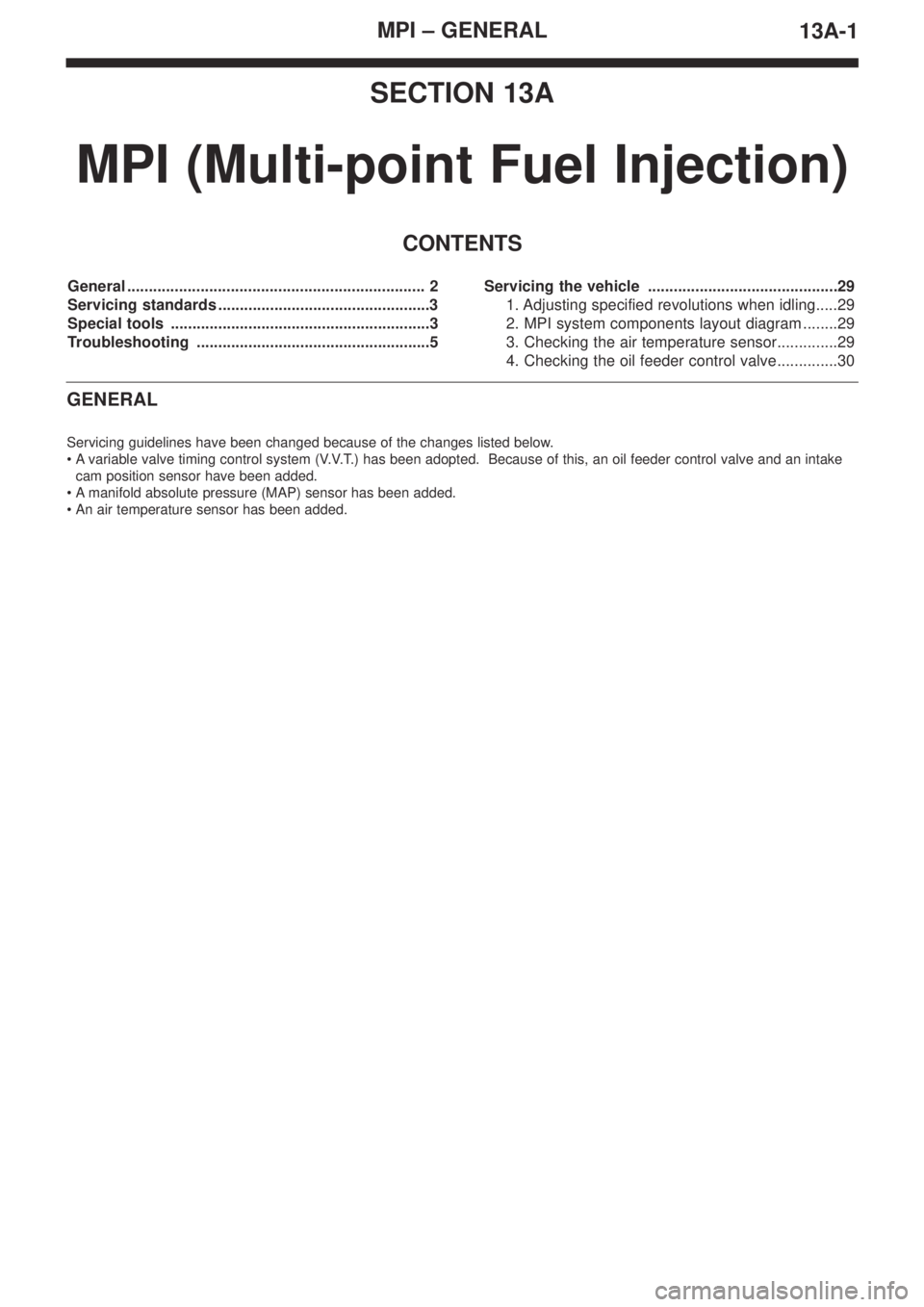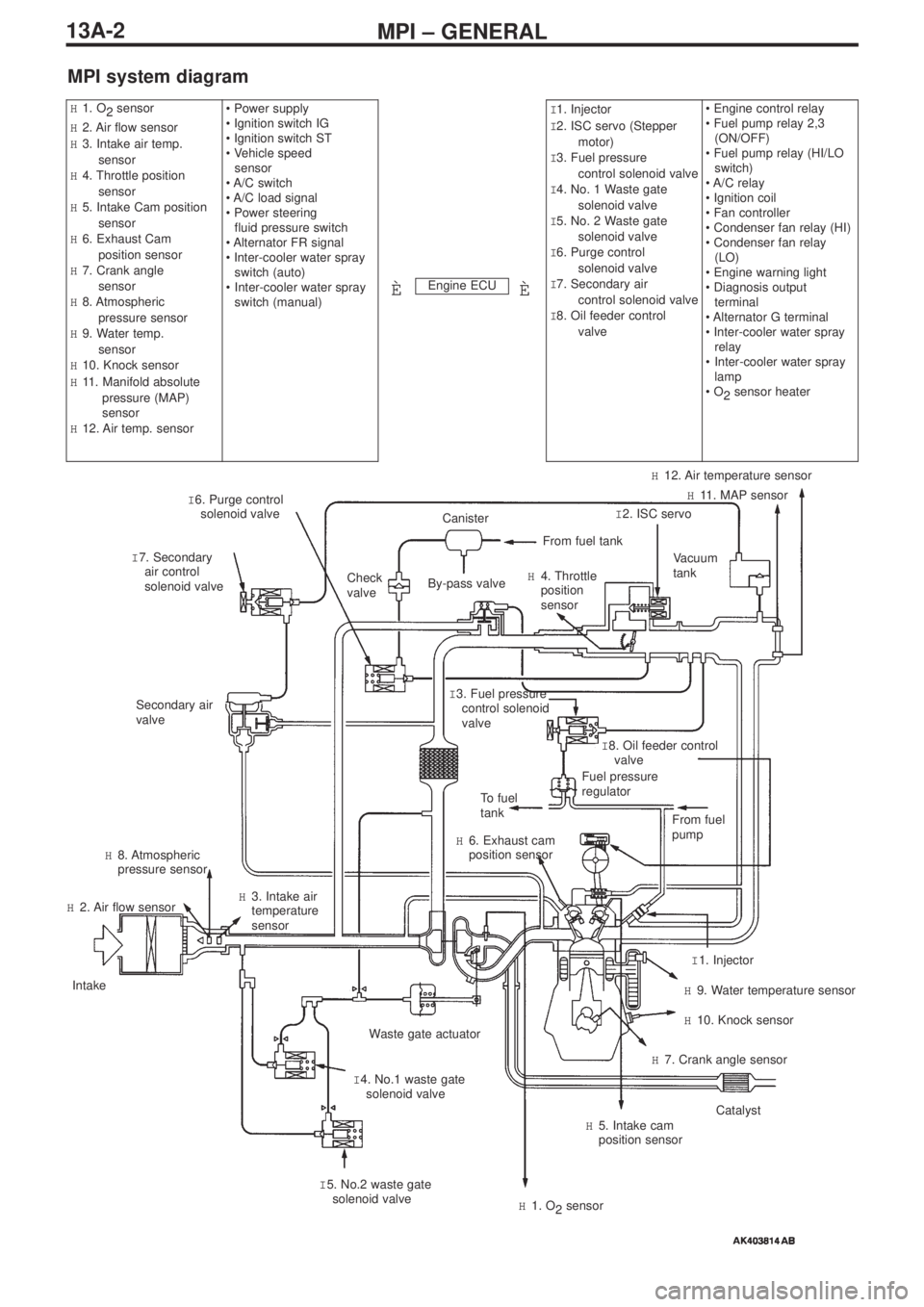Page 32 of 364

ENGINE – TIMING BELT, TIMING BELT B11-26
� �
F� �
Fitting the timing belt
1. Check that all the timing marks for the camshaft sprocket, the
crankshaft sprocket and the oil pump sprocket are aligned.
2. After the timing marks for the oil pump sprocket have been
aligned, remove the plug from the cylinder block and insert a
posidrive (+) with a diameter of 8 mm into the plug hole. Check
that more than 60 mm of the shaft of the screwdriver can be
inserted. If the screwdriver strikes the balancer shaft and can
only be inserted to a depth of 20 ~ 25 mm, turn the sprocket one
complete turn, realign the timing marks, and check that more
than 60 mm of the screwdriver can be inserted. Do not remove
the screwdriver until the timing belt has been fitted.
3. Install the timing belt in accordance with the following guidelines
so that the side that is under tension does not get slack.
(1) Fit the timing belt around the crankshaft sprocket first, then
the oil pump sprocket and then fit it around the idler pulley.
(2) Fit the timing belt around the camshaft sprocket (exhaust
side) and hold it in place with a paper clip at the position
shown in the diagram.
timing marks
camshaft
sprocket (inlet
side)
timing
marks
crankshaft
sprocket
camshaft
sprocket
(exhaust
side)
timing
marks
oil pump
sprocket
plug
more than
60 mm
screwdriver
balancer shaft
camshaft
sprocket (inlet
side)
tensioner pulley
crankshaft
sprocket
camshaft
sprocket
(exhaust side)
idler
pulley
oil pump
sprocket
paper
clip
Page 34 of 364

ENGINE – TIMING BELT, TIMING BELT B, ENGINE ASSY11-28
5. Using the special wrench for the tensioner pulley socket
(MD998767) or a torque wrench, apply tension torque (3.5 N·m)
to the timing belt in the direction shown in the diagram, and
tighten the mounting bolt for the tensioner pulley to the specified
torque.
Tightening torque: 48 ± 5 N·m
Caution
When tightening the installed bolt, take care that the
tensioner pulley does not turn around with it. If the pulley
does turn around with the bolt, the tension of the belt will
become too strong.
6. Remove the wire or pin which had been inserted when the auto-
tensioner was fitted.
7. Remove by hand the special adjusting bolt (MD998738) which
had been fitted in step 1.
8. Turn the crankshaft two complete turns in a clockwise direction,
and leave it for about 15 minutes.
9. Reinsert the wire or pin which had been removed in step 6, and
check that it can be easily pulled out again.
If the wire or pin can be easily pulled out the tension of the
timing belt is just right, so the wire or pin should be removed
completely. At this point check that the auto-tensioner rod is not
projecting more than the amount specified.
Specified projection (A): 3.8 ~ 4.5 mm
10. If the wire or pin cannot be easily pulled out, repeat steps 1 to 8
until the tension of the timing belt is just right.
11.Recheck that the timing marks on all of the sprockets are in line.
Caution
If the crankshaft bolt is turned in an anti-clockwise
direction, the tightening torque of the crankshaft bolt must
be checked, and if it is loose, it must be retightened.
ENGINE ASSY
Removal and fitting
Jobs to be completed before removal and after fitting
•Measures to prevent fuel leaking.
•Check for fuel dripping.
•Removal and refitting of the bonnet.
•Removal and refitting of the strut tower bar.
•Removal and refitting of the valence. (Ref Section 51: Front bumper)
•Checking the tension of the drive belt.
•Adjustment of the axle letter cable.
•Draining and replacing the engine oil.
•Draining and replacing the coolant.
•Removal and refitting of the air cleaner.
•Removal and refitting of air pipe C.
•Removal and refitting of the battery and the battery tray.
•Removal and refitting of the centre cover. (Ref P11-5)
•Removal and refitting of the axle letter cable.
•Removal and refitting of the radiator.
•Removal and refitting of the front exhaust pipe.
Page 38 of 364
ENGINE – ENGINE ASSY11-32
� �
D� �
Removing the engine mount bracket & stopper ASSY
1. Support the engine using a garage jack.
2. Remove the special mechanical engine hanger (MZ203830,
MZ203831 or MB991928).
3. Hold the engine ASSY using a chain block.
4. Support the engine oil pan component with the garage jack
through the engine block, so that the weight of the engine is not
taken by the engine mount bracket.
5. Loosen the nuts and bolts and remove the engine mount bracket
and stopper ASSY.
� �
E� �
Removing the engine ASSY
After checking that all of the cables, hoses and harness connectors
etc have been disconnected, slowly hoist the engine using a chain
block and remove the engine from the engine compartment.
Fitting guidelines
� �
A� �
Fitting the engine ASSY
Install the engine whilst checking that cables, hoses and harness
connectors etc will not be squashed beneath it.
MZ203830 or MZ203831
slide bracket (HI)
Page 39 of 364

ENGINE – ENGINE ASSY
11-33
� �
B� �
Fitting the engine mount bracket & stopper ASSY
1. Support the engine oil pan component with the garage jack
through the engine block, and fit the engine mount bracket &
stopper ASSY whilst checking the position of the engine. Fix the
engine mount stopper so that the arrow points in the direction
shown in the diagram.
2. Support the engine ASSY with a garage jack.
3. Remove the chain block.
4. In the same way as when it was removed, hold the engine
ASSY with the special tool.
(1)
(MZ203830 or MZ203831)>
Install the special mechanical engine hanger (MZ203830
or MZ203831).
(2)
Fit the following parts to the base hanger.
• Slide bracket (HI)
• Foot (standard) (MB991932)
• Joint (90) (MB991930)
Install the special engine hanger (MB991928)
� �
C� �
Fitting the transfer ASSY and the transmission ASSY
1. Fit the transfer ASSY and the transmission ASSY.
2. Remove the radiator support upper insulator mounting bolts from
the chassis (2 places).engine sideengine side
engine mount stopper
rear of chassis>
front of chassis>
MZ203830 or MZ203831
slide bracket (HI)
front of
chassis
joint (90)
(MB991930)
foot (standard) (MB991932)
slide bracket (HI)
Page 40 of 364
ENGINE – ENGINE ASSY11-34
� �
D� �
Fitting the O-ring and the fuel high pressure hose
1. Apply a little fresh engine oil to the O-ring.
Caution
Ensure that no engine oil gets inside the deliver pipe.
2. Without damaging the O-ring, fit the fuel high pressure hose to
the delivery pipe by twisting it from left to right. Ensure that the
hose is twisted smoothly.
3. If the hose cannot be twisted smoothly, there is a possibility that
it may be biting into the O-ring, so remove the fuel high pressure
hose, and check for any damage to the O-ring. If the O-ring is
undamaged, reinsert it into the delivery pipe and check once
more whether the hose can be turned smoothly.
4. Tighten the mounting bolts for the fuel high pressure hose, to
the specified torque.
Tightening torque: 5.0 ± 1.0 N•m.
Page 41 of 364

MPI – GENERAL
13A-1
SECTION 13A
MPI (Multi-point Fuel Injection)
CONTENTS
General ..................................................................... 2
Servicing standards .................................................3
Special tools ............................................................3
Troubleshooting ......................................................5Servicing the vehicle ............................................29
1. Adjusting specified revolutions when idling.....29
2. MPI system components layout diagram ........29
3. Checking the air temperature sensor..............29
4. Checking the oil feeder control valve..............30
GENERAL
Servicing guidelines have been changed because of the changes listed below.
•Avariable valve timing control system (V.V.T.) has been adopted. Because of this, an oil feeder control valve and an intake
cam position sensor have been added.
•Amanifold absolute pressure (MAP) sensor has been added.
•An air temperature sensor has been added.
Page 42 of 364

MPI – GENERAL13A-2
MPI system diagram
Engine ECU
H1. O
2 sensor
H2. Air flow sensor
H3. Intake air temp.
sensor
H4. Throttle position
sensor
H5. Intake Cam position
sensor
H6. Exhaust Cam
position sensor
H7. Crank angle
sensor
H8. Atmospheric
pressure sensor
H9. Water temp.
sensor
H10. Knock sensor
H11. Manifold absolute
pressure (MAP)
sensor
H12. Air temp. sensor• Power supply
• Ignition switch IG
• Ignition switch ST
• Vehicle speed
sensor
• A/C switch
• A/C load signal
• Power steering
fluid pressure switch
• Alternator FR signal
• Inter-cooler water spray
switch (auto)
•Inter-cooler water spray
switch (manual)I1. Injector
I2. ISC servo (Stepper
motor)
I3. Fuel pressure
control solenoid valve
I4. No. 1 Waste gate
solenoid valve
I5. No. 2 Waste gate
solenoid valve
I6. Purge control
solenoid valve
I7. Secondary air
control solenoid valve
I8. Oil feeder control
valve• Engine control relay
• Fuel pump relay 2,3
(ON/OFF)
• Fuel pump relay (HI/LO
switch)
• A/C relay
• Ignition coil
• Fan controller
• Condenser fan relay (HI)
• Condenser fan relay
(LO)
• Engine warning light
• Diagnosis output
terminal
• Alternator G terminal
• Inter-cooler water spray
relay
•Inter-cooler water spray
lamp
• O
2sensor heater
ÈÈ
I 6. Purge control
solenoid valve
I 7. Secondary
air control
solenoid valveCheck
valve
Secondary air
valve
To fuel
tank
H 6. Exhaust cam
position sensor
H 8. Atmospheric
pressure sensor
H 2. Air flow sensor
Intake
Waste gate actuator
I 4. No.1 waste gate
solenoid valve H 3. Intake air
temperature
sensor
I 5. No.2 waste gate
solenoid valve
H 1. O
2sensor
H 5. Intake cam
position sensorCatalyst
H 7. Crank angle sensor
H 10. Knock sensor
H 9. Water temperature sensor
I 1. Injector From fuel
pump
Fuel pressure
regulatorI 8. Oil feeder control
valve I 3. Fuel pressure
control solenoid
valve
Vacuum
tank
I 2. ISC servoH 11. MAP sensor
H 12. Air temperature sensor
H 4. Throttle
position
sensor
From fuel tank
Canister
By-pass valve
Page 43 of 364
MPI – SERVICING STANDARDS, SPECIAL TOOLS
13A-3
Servicing standards
Special tools
ItemStandard level
Revolutions when idling r/min800 ± 50
Air temperature sensor resistance kΩat -20 ºC13~18
at 0 ºC5.1~6.9
at 20 ºC2.0~3.0
at 40 ºC0.9~1.5
at 60 ºC0.40~0.78
at 80 ºC0.23~0.42
Oil feeder control valve resistance (at 20 ºC) Ω6.9~7.9
ToolNumberNameFunction
MB991502MUT-II sub ASSYChecking the MPI system
MB991955
A:MB991824
B:MB991827
C:MB991910
D:MB991911
E:MB991825
F:MB991826MUT-III sub ASSY
A: Vehicle Communication
Interface (V.C.I..)
B: USB cable
C: MUT-III Main harness A
(For vehicles fitted with
CAN)
D: MUT-III Main harness B
(For vehicles not fitted with
CAN)
E: Adaptor
F: Trigger harnessNote
If a MUT-III main harness A is connected to
a vehicle not fitted with CAN, there is a
chance that a pulse signal will be entered
in the simulated vehicle speed line, when
the MUT-III is activated. Therefore, use a
MUT-III main harness B with vehicles not
fitted with CAN.
DO NOT USE